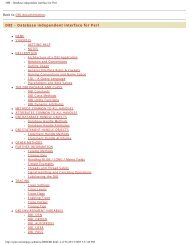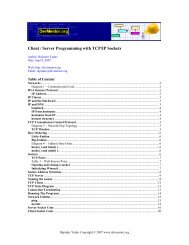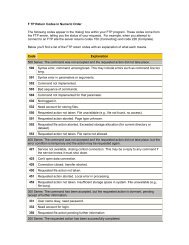Introduction to FTP protocol - Level5Software.net
Introduction to FTP protocol - Level5Software.net
Introduction to FTP protocol - Level5Software.net
Create successful ePaper yourself
Turn your PDF publications into a flip-book with our unique Google optimized e-Paper software.
<strong>Introduction</strong> <strong>to</strong> <strong>FTP</strong> pro<strong>to</strong>col<br />
<strong>FTP</strong> pro<strong>to</strong>col (File Transfer Pro<strong>to</strong>col) is, as its name indicates a pro<strong>to</strong>col for transferring files.<br />
The implementation of <strong>FTP</strong> dates from 1971 when a file transfer system (described in RFC141) between<br />
MIT machines (Massachusetts Institute of Technology) was developed. Many RFC have since made<br />
improvements <strong>to</strong> the basic pro<strong>to</strong>col, but the greatest innovations date from July 1973.<br />
The <strong>FTP</strong> pro<strong>to</strong>col is currently defined by RFC 959 (File Transfer Pro<strong>to</strong>col (<strong>FTP</strong>) - Specifications).<br />
The role of <strong>FTP</strong> pro<strong>to</strong>col<br />
<strong>FTP</strong> pro<strong>to</strong>col defines the way in which data must be transferred over a TCP/IP <strong>net</strong>work.<br />
The aim of <strong>FTP</strong> pro<strong>to</strong>col is <strong>to</strong>:<br />
<br />
<br />
<br />
allow file sharing between remote machines<br />
allow independence between client and server machine system files<br />
enable efficient data transfer<br />
The <strong>FTP</strong> model<br />
<strong>FTP</strong> pro<strong>to</strong>col falls within a client-server model, i.e. one machine sends orders (the client) and the other<br />
awaits requests <strong>to</strong> carry out actions (the server).<br />
During an <strong>FTP</strong> connection, two transmission channels are open:<br />
<br />
<br />
A channel for commands (control channel)<br />
A channel for data<br />
So, both the client and server have two processes allowing these two types of information <strong>to</strong> be managed:<br />
<br />
<br />
DTP (Data Transfer Process) is the process in charge of establishing the connection and managing the<br />
data channel. The server side DTP is called SERVER-DTP, the client side DTP is called USER-DTP<br />
PI (Pro<strong>to</strong>col Interpreter) interprets the pro<strong>to</strong>col allowing the DTP <strong>to</strong> be controlled using commands<br />
received over the control channel. It is different on the client and the server:
The SERVER-PI is responsible for listening <strong>to</strong> the commands coming from a USER-PI over the control<br />
channel on a data port, establishing the connection for the control channel, receiving <strong>FTP</strong> commands<br />
from the USER-PI over this, responding <strong>to</strong> them and running the SERVER-DTP.<br />
The USER-PI is responsible for establishing the connection with the <strong>FTP</strong> server, sending <strong>FTP</strong><br />
commands, receiving responses from the SERVER-PI and controlling the USER-DTP if needed.<br />
When an <strong>FTP</strong> client is connected <strong>to</strong> a <strong>FTP</strong> server, the USER-PI initiates the connection <strong>to</strong> the server<br />
according <strong>to</strong> the Tel<strong>net</strong> pro<strong>to</strong>col. The client sends <strong>FTP</strong> commands <strong>to</strong> the server, the server interprets them,<br />
runs its DTP, then sends a standard response. Once the connection is established, the server-PI gives the<br />
port on which data will be sent <strong>to</strong> the Client DTP. The client DTP then listens on the specified port for data<br />
coming from the server.<br />
It is important <strong>to</strong> note that since the control and data ports are separate channels, it is possible <strong>to</strong> send<br />
commands from one machine and receive data on another. So, for example it is possible <strong>to</strong> transfer data<br />
between <strong>FTP</strong> servers by passing through a client <strong>to</strong> send control instructions and by transferring information<br />
between two server processes connected on the right port.<br />
In this configuration, the pro<strong>to</strong>col imposes that the control channels remain open throughout the data<br />
transfer. So a server can s<strong>to</strong>p a transmission if the control channel is broken during transmission.<br />
The <strong>FTP</strong> commands<br />
All communication conducted on the control channel follows Tel<strong>net</strong> pro<strong>to</strong>col recommendations. So, the <strong>FTP</strong><br />
commands are Tel<strong>net</strong> character strings (in NVT-ASCII code) ending in the Tel<strong>net</strong> end of line code (i.e. the<br />
sequence +, Carriage Return followed by the Line Feed character, noted ).<br />
If the <strong>FTP</strong> command has a parameter, this is separated from the command by a space ().<br />
<strong>FTP</strong> commands make it possible <strong>to</strong> specify:
The port used<br />
The method of data transfer.<br />
Data structure<br />
The nature of the action <strong>to</strong> be conducted (Retrieve, List, S<strong>to</strong>re, etc.)<br />
There are three different types of <strong>FTP</strong> commands:<br />
<br />
<br />
<br />
Access control commands<br />
Transfer parameter commands<br />
<strong>FTP</strong> service commands<br />
Access control commands<br />
Command<br />
USER<br />
PASS<br />
ACCT<br />
CWD<br />
CDUP<br />
SMNT<br />
REIN<br />
QUIT<br />
Description<br />
Character string allowing the user <strong>to</strong> be identified. User identification is necessary <strong>to</strong> establish<br />
communication over the data channel.<br />
Character string specifying the user's password. This command must immediately precede the<br />
USER command. It falls <strong>to</strong> the client <strong>to</strong> hide the display of this command for security reasons.<br />
Character string representing the user's account. The command is generally not necessary.<br />
During the response accepting the password, if the response is 230 this stage is not necessary,<br />
if the response is 332, it is.<br />
Change Working Direc<strong>to</strong>ry: this command enables the current direc<strong>to</strong>ry <strong>to</strong> be changed. This<br />
command requires the direc<strong>to</strong>ry's access path <strong>to</strong> be fulfilled as an argument.<br />
Change <strong>to</strong> Parent Direc<strong>to</strong>ry: this command allows you <strong>to</strong> go back <strong>to</strong> the parent direc<strong>to</strong>ry. It was<br />
introduced <strong>to</strong> solve problems of naming the parent direc<strong>to</strong>ry according <strong>to</strong> the system (generally<br />
"..").<br />
Structure Mount:<br />
Reinitialize:<br />
Command enabling the current session <strong>to</strong> be terminated. The server waits <strong>to</strong> finish the transfer<br />
in progress if the need arises, then supplies a response before closing the connection.<br />
Transfer parameter commands<br />
Command<br />
PORT<br />
PASV<br />
TYPE<br />
Description<br />
Character string allowing the port number used <strong>to</strong> be specified.<br />
Command making it possible <strong>to</strong> indicate <strong>to</strong> the DTP server <strong>to</strong> stand by for a connection on a<br />
specific port chosen randomly from among the available ports. The response <strong>to</strong> this command<br />
is the IP address of the machine and port.<br />
This command enables the type of format in which the data will be sent <strong>to</strong> be specified.
STRU<br />
MODE<br />
Tel<strong>net</strong> character specifying the file structure (F for File, R for Record, P for Page).<br />
Tel<strong>net</strong> character specifying data transfer method (S for Stream, B for Block, C for Compressed).<br />
<strong>FTP</strong> service commands<br />
Command<br />
RETR<br />
STOR<br />
STOU<br />
APPE<br />
ALLO<br />
REST<br />
RNFR<br />
RNTO<br />
ABOR<br />
DELE<br />
RMD<br />
MKD<br />
PWD<br />
LIST<br />
Description<br />
This command (RETRIEVE) asks the server DTP for a copy of the file whose access path is<br />
given in the parameters.<br />
This command (s<strong>to</strong>re) asks the server DTP <strong>to</strong> accept the data sent over the data channel and<br />
s<strong>to</strong>re them in a file bearing the name given in the parameters. If the file does not exist, the<br />
server creates it, if not it overwrites it.<br />
This command is identical <strong>to</strong> the previous one, only it asks the sever <strong>to</strong> create a file where the<br />
name is unique. The name of the file is returned in the response.<br />
Thanks <strong>to</strong> this command (append) the data sent is concatenated in<strong>to</strong> the file bearing the name<br />
given in the parameter if it already exists, if not, it is created.<br />
This command (allocate) asks the server <strong>to</strong> plan a s<strong>to</strong>rage space big enough <strong>to</strong> hold the file<br />
whose name is given in the argument.<br />
This command (restart) enables a transfer <strong>to</strong> be restarted from where it s<strong>to</strong>pped. To do so, the<br />
command sends the marker representing the position in the file where the transfer had been<br />
interrupted in the parameter. This command must immediately follow a transfer command.<br />
This command (rename from) enables a file <strong>to</strong> be renamed. In the parameters it indicates the<br />
name of the file <strong>to</strong> be renamed and must be immediately followed by the RNTO command.<br />
This command (rename <strong>to</strong>) enables a file <strong>to</strong> be renamed. In the parameters it indicates the<br />
name of the file <strong>to</strong> be renamed and must be immediately followed by the RNFR command.<br />
This command (abort) tells the server DTP <strong>to</strong> abandon all transfers associated with the previous<br />
command. If no data connection is open, the DTP sever does nothing, if not it closes it. The<br />
control channel however remains open.<br />
This command (delete) allows a file <strong>to</strong> be deleted, the name of which is given in the<br />
parameters. This command is irreversible, confirmation can only be given at client level.<br />
This command (remove direc<strong>to</strong>ry) enables a direc<strong>to</strong>ry <strong>to</strong> be deleted. The name of the direc<strong>to</strong>ry<br />
<strong>to</strong> be deleted is indicated in the parameters.<br />
This command (make direc<strong>to</strong>ry) causes a direc<strong>to</strong>ry <strong>to</strong> be created. The name of the direc<strong>to</strong>ry <strong>to</strong><br />
be created is indicated in the parameters.<br />
This command (print working direc<strong>to</strong>ry) makes it possible <strong>to</strong> resend the complete current<br />
direc<strong>to</strong>ry path.<br />
This command allows the list of files and direc<strong>to</strong>ries present in the current direc<strong>to</strong>ry <strong>to</strong> be<br />
resent. This is sent over the passive DTP. It is possible <strong>to</strong> place a direc<strong>to</strong>ry name in the<br />
parameter of this command, the server DTP will send the list of files in the direc<strong>to</strong>ry placed in<br />
the parameter.
NLST<br />
SITE<br />
SYST<br />
STAT<br />
HELP<br />
This command (name list) enables the list of files and direc<strong>to</strong>ries present in the current<br />
direc<strong>to</strong>ry <strong>to</strong> be sent.<br />
This command (site parameters) causes the server <strong>to</strong> offer specific services not defined in the<br />
<strong>FTP</strong> pro<strong>to</strong>col.<br />
This command (system) allows information on the remote server <strong>to</strong> be sent.<br />
This command (status) makes it possible <strong>to</strong> transmit the status of the server, for example <strong>to</strong><br />
know the progress of a current transfer. This command accepts an access path in the<br />
argument, it then returns the same information as LIST but over the control channel.<br />
This command gives all the commands unders<strong>to</strong>od by the server. The information is returned<br />
on the control channel.<br />
NOOP<br />
The <strong>FTP</strong> responses<br />
This command (no operations) is only used <strong>to</strong> obtain an OK command from the server. It can<br />
only be used in order not <strong>to</strong> be disconnected after an excessive period of inactivity.<br />
The <strong>FTP</strong> responses make it possible <strong>to</strong> ensure synchronisation between the client and <strong>FTP</strong> server. So, at<br />
each command sent by the client, the server will potentially carry out an action and systematically send back<br />
a response.<br />
The responses are made up of a 3 digit code indicating the way in which the command sent by the client has<br />
been processed. However, since this 3 digit code is hard <strong>to</strong> read for humans, it is accompanied by a text<br />
(Tel<strong>net</strong> character string separated from the numeric code by a space).<br />
The response codes are made up of 3 numbers the meanings of which are as follows:<br />
<br />
<br />
<br />
The first number indicates the status of the response (success or fail)<br />
The second number indicates what the response refers <strong>to</strong>.<br />
The third number gives a more specific meaning (relative <strong>to</strong> each second digit)<br />
First number<br />
Digit Meaning Description<br />
1yz<br />
2yz<br />
3yz<br />
4yz<br />
5yz<br />
Preliminary positive<br />
response<br />
Positive fulfilment<br />
response<br />
Intermediary positive<br />
response<br />
Negative fulfilment<br />
response<br />
Permanent negative<br />
response<br />
The action requested is in progress, a second response must be obtained<br />
before sending a second command<br />
The action requested has been fulfilled, a new command can be sent<br />
The action request is temporarily suspended. Additional information is awaited<br />
from the client<br />
The action requested has not taken place because the command has<br />
temporarily not been accepted. The client is requested <strong>to</strong> try again later<br />
The action requested has not taken place because the command has not been<br />
accepted. The client is requested <strong>to</strong> formulate a different request<br />
Second number
Digit Meaning Description<br />
x0z<br />
x1z<br />
Syntax<br />
Information<br />
The action has a syntax error, or is a command not unders<strong>to</strong>od by the<br />
server<br />
This is a response sending back information (for example a response <strong>to</strong> a<br />
STAT command)<br />
x2z Connections The response relates <strong>to</strong> the data channel<br />
x3z<br />
x4z<br />
Authentication and<br />
accounts<br />
Not used by the <strong>FTP</strong><br />
pro<strong>to</strong>col<br />
The response relates <strong>to</strong> the (USER/PASS) login or the request <strong>to</strong> change<br />
the account (CPT)<br />
x5z File system The response relates <strong>to</strong> the remote file system










